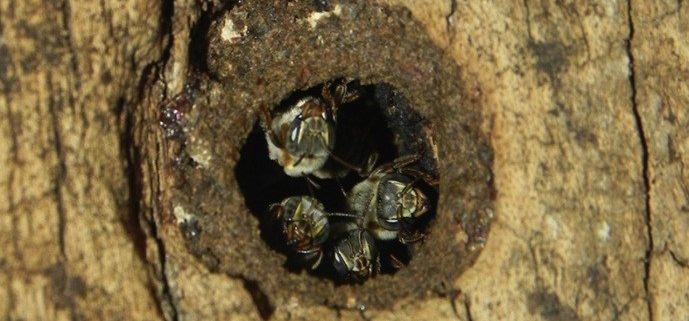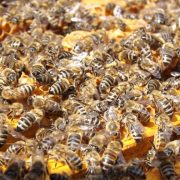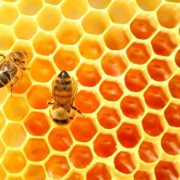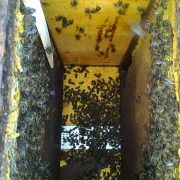People and bees. Mayan bees in the Madrid Codex
By Luis Bringas
Every morning, when you have a cup of coffee, orange juice or sparkling bread with honey, without even account, enjoyed an ecosystem called pollination which depend three out of four edible plants. According to the Food and Agriculture Organization (FAO), the economic contribution of pollination is estimated to be up to 170.00 million annually, equivalent to 10% of the total food value.
Specifically, it has been determined that pollination is important to 100 plant species among which fruits and vegetables, with a third of the economic-value closely followed by legumes and cereals. Although there are several agents or vectors such as wind, water, insects, mammals, birds and reptiles, it is recognized that bees are universal pollinator.
Even the story relates the importance of bees to use their image to represent the power of people like Napoleon Bonaparte, Julius Caesar or Ramses II. However, the Mayans were the first to recognize the power of bees and left their pictorial record in the codices or secret books that were used from the sixth century a.C. until the sixteenth century.
Honey Ladies
Given the obvious importance of bees as pollinators, the same FAO reports that there are records of more than 20,000 species of bees, including 3,500 stand as responsible for increasing agricultural yields.
While the world stands the honeybee Apis or European bee, exists in Mexico and Guatemala a variety of native bees, known as Mayan bees (xumman kaab and ko ólel kaab), whose hives are found in tropical regions of the Yucatan Peninsula, a large limestone plateau of 140,000 km2 where tropical deciduous forests, with creepers, vines, creepers, barbascos (makal kuch, xtabentun) predominate; trees and shrubs and various blooms such as katsim (Mimosa bahamensis) and sak piksoy (Trema micrantha) sak.
In this paradise of plants, flowers and crystal clear cenotes, there are Mayan communities in Tixkacalpupul near Valladolid, where you can still find prehispanic type hives, which are grown in hollowed tree trunks near the archaeological site of Chichen-Itza.
Social beings highly organized
In this region located west of the Yucatan, Mayan beekeepers call jobones to their hives, and are part of a ritual that uses a number of brands to identify the top of the troncos hollowed where entering and leaving the bees. These marks are usually crosses, circles or squares represent the universe by which bees are able to go heaven and earth. The current Mayan beekeepers, led by priests of their community, indicate that the bees go up to heaven, where chaques (rain gods) guarding the troughs filled with honey, the bees are responsible for lowering in drops to delight men.
Thanks to their dedication and customs, Mayan beekeepers are major honey producers in Mexico because they get almost 60% of total Mexican production, which reached 56.907 tons in 2015, according to reports of Agricultural Information System ( SIAP) of SAGARPA. Thanks to its quality, the Mayan honey (nine out of ten kilos obtained from the hives of Yucatan, Campeche and Quintana Roo) is mainly exported to European countries where it is very appreciated for its nutritional and energy values. This livestock resource, generates revenues approximate $ 150 million annual from exports.
Honey types
In the inventory of the Mayan honey, include the honey jungle of Quintana Roo, known as Tajonal honey; Bejuco Honey Chan Cenote; Mococha honey creeper, Yucatan, and those obtained from various blooms in Dzindazantún and Sinanche, Ich Ek Yucatan and Campeche. In Belize and Guatemala, have also found traces of hives in Altun Ha, Uaxactun, and San Augustin Acasaguastlán, worth mentioning that the production of these wild bees, called sacred bees, quite different from domesticated bees, since in principle the bees no sting and do not nest in hexagonal structures, but in small ramekins or anforitas wax.
One aspect that is doubly curious, is that the information of sacred bees, known as section of honeybees is registered in the Code Tro Cortesiano (Madrid Codex) that consists of a series of documents small format of 10 x 20 cms (like a magazine) that Mayan priests used to document sacred and secret aspects. The best known Maya codices are in Dresden, Paris and Madrid. There are also archaeological codices found in protected sites and popular transcripts of these codices called Chilam Balam and Popol Vuh.
Finally one of the most interesting aspects is that for the Maya, bees and people not only share a territory that can be mount or fields where the honey is produced but also the urban domestic territory called alak. For the Maya priests, there is no doubt that the destiny of men and bees is attached and therefore the bees are call ¨people¨. This duality or parallel is perhaps what unites men with the future of bees and why the Maya beekeepers showed that bees are the queens of the universe, recently winning the battle against GM crops in Yucatan.













